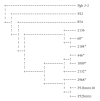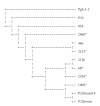Algorithmic assessment of vaccine-induced selective pressure and its implications on future vaccine candidates
- PMID: 20150957
- PMCID: PMC2817498
- DOI: 10.1155/2010/178069
Algorithmic assessment of vaccine-induced selective pressure and its implications on future vaccine candidates
Abstract
Posttrial assessment of a vaccine's selective pressure on infecting strains may be realized through a bioinformatic tool such as parsimony phylogenetic analysis. Following a failed gonococcal pilus vaccine trial of Neisseria gonorrhoeae, we conducted a phylogenetic analysis of pilin DNA and predicted peptide sequences from clinical isolates to assess the extent of the vaccine's effect on the type of field strains that the volunteers contracted. Amplified pilin DNA sequences from infected vaccinees, placebo recipients, and vaccine specimens were phylogenetically analyzed. Cladograms show that the vaccine peptides have diverged substantially from their paternal isolate by clustering distantly from each other. Pilin genes of the field clinical isolates were heterogeneous, and their peptides produced clades comprised of vaccinated and placebo recipients' strains indicating that the pilus vaccine did not exert any significant selective pressure on gonorrhea field strains. Furthermore, sequences of the semivariable and hypervariable regions pointed out heterotachous rates of mutation and substitution.
Figures




Similar articles
-
Identification of epitopes recognized by monoclonal antibodies SM1 and SM2 which react with all pili of Neisseria gonorrhoeae but which differentiate between two structural classes of pili expressed by Neisseria meningitidis and the distribution of their encoding sequences in the genomes of Neisseria spp.J Gen Microbiol. 1989 Dec;135(12):3239-51. doi: 10.1099/00221287-135-12-3239. J Gen Microbiol. 1989. PMID: 2483993
-
Characterization of a class II pilin expression locus from Neisseria meningitidis: evidence for increased diversity among pilin genes in pathogenic Neisseria species.Infect Immun. 1997 Jul;65(7):2613-20. doi: 10.1128/iai.65.7.2613-2620.1997. Infect Immun. 1997. PMID: 9199428 Free PMC article.
-
Human immunization with Pgh 3-2 gonococcal pilus results in cross-reactive antibody to the cyanogen bromide fragment-2 of pilin.J Infect Dis. 1991 Jan;163(1):128-34. doi: 10.1093/infdis/163.1.128. J Infect Dis. 1991. PMID: 1701817 Clinical Trial.
-
Neisseria gonorrhoeae vaccine development: hope on the horizon?Curr Opin Infect Dis. 2018 Jun;31(3):246-250. doi: 10.1097/QCO.0000000000000450. Curr Opin Infect Dis. 2018. PMID: 29601324 Review.
-
The role of pilin glycan in neisserial pathogenesis.Mol Cell Biochem. 2003 Nov;253(1-2):179-90. doi: 10.1023/a:1026058311857. Mol Cell Biochem. 2003. PMID: 14619968 Review.
Cited by
-
Inhibition of IL-10 production by maternal antibodies against Group B Streptococcus GAPDH confers immunity to offspring by favoring neutrophil recruitment.PLoS Pathog. 2011 Nov;7(11):e1002363. doi: 10.1371/journal.ppat.1002363. Epub 2011 Nov 17. PLoS Pathog. 2011. PMID: 22114550 Free PMC article.
-
The application of evolutionary medicine principles for sustainable malaria control: a scoping study.Malar J. 2016 Jul 22;15(1):383. doi: 10.1186/s12936-016-1446-8. Malar J. 2016. PMID: 27449143 Free PMC article.
-
Systems Biology Profiling of AMD on the Basis of Gene Expression.J Ophthalmol. 2013;2013:453934. doi: 10.1155/2013/453934. Epub 2013 Nov 14. J Ophthalmol. 2013. PMID: 24349763 Free PMC article.
-
PhyloOncology: Understanding cancer through phylogenetic analysis.Biochim Biophys Acta Rev Cancer. 2017 Apr;1867(2):101-108. doi: 10.1016/j.bbcan.2016.10.006. Epub 2016 Oct 31. Biochim Biophys Acta Rev Cancer. 2017. PMID: 27810337 Free PMC article. Review.
-
Study of Clinical Survival and Gene Expression in a Sample of Pancreatic Ductal Adenocarcinoma by Parsimony Phylogenetic Analysis.OMICS. 2016 Jul;20(7):442-7. doi: 10.1089/omi.2016.0059. OMICS. 2016. PMID: 27428255 Free PMC article.
References
-
- Check Hayden E. HIV: the next shot. Nature. 2008;454(7204):565–569. - PubMed
-
- Goloboff PA, Pol D. Parsimony and bayesian phylogenetics. In: Albert VA, editor. Parsimony, Phylogeny, and Genomics. Oxford, UK: Oxford University Press; 2005.
-
- Paraskevis D, Magiorkinis E, Magiorkinis G, et al. Increasing prevalence of HIV-1 subtype a in Greece: estimating epidemic history and origin. Journal of Infectious Diseases. 2007;196(8):1167–1176. - PubMed
LinkOut - more resources
Full Text Sources

